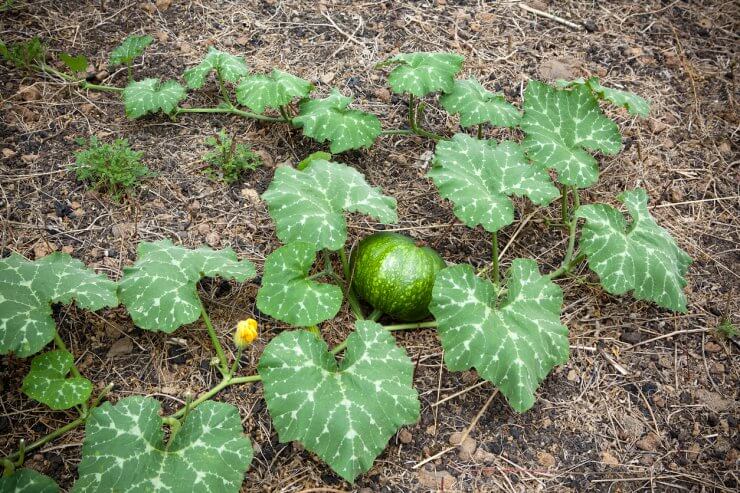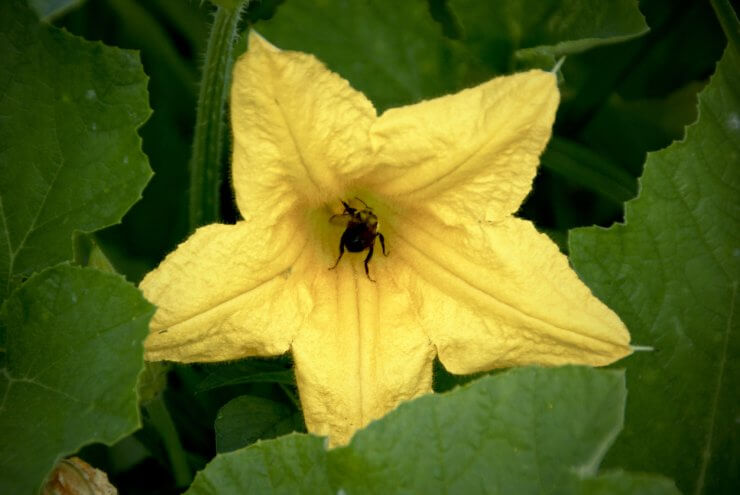
Kabocha squash in the garden
Watering your winter squash plants
Once your winter squash are settled in—whether it’s in a container, raised bed, or open ground—consistency is key when it comes to watering. If you don’t get rain on a regular basis, go out and give your winter squash a good drink of water. Winter squash like soil that’s moist, but not soggy. Don’t kill your squash plants with kindness. Water, yes—just not too much.
In general, you’ll want to water deeply about once a week, so your plants get about an inch of water. If the top of the soil is a little dry, that’s OK. But don’t let the soil dry out. Lay down a layer of mulch to help retain moisture; ground-up leaves, clean grass clippings (no pesticides), or compost work well.
It’s always best to water in the morning, so your plants can soak up the water and put it to work. Water the soil, not the leaves or the growing squash. Aim for the base of the plant. Try not to get the leaves wet (unless you’re blasting off pests) as this can open the plant to fungal infection. In that case, be sure the leaves dry off.
One note about wet squash leaves and vines: don’t touch them if you don’t have to. It’s too easy to transfer fungal infections from one plant to another that way. If you do wind up with fungus on your leaves, carefully cut them from the plant and bag them right there so you don’t transfer spores to other parts of your garden. Throw out the infected plant material. Don’t compost it.
Weeding your winter squash plants
If you’ve planted in raised beds or containers, weeds shouldn’t be much of a problem. If you do see weeds, pull them early and often—but be gentle about it. Loosen the soil gently around your plants, especially when they’re young, so you don’t disturb their roots. For raised beds and containers, this is another good reason to get yourself some fresh garden soil; it’s one less piece of aggravation to deal with during the growing season.
But even if you’re growing your winter squash directly in the ground, properly preparing your soil is still an excellent preventive measure against the emergence of weeds. When you till or cultivate the area where you’ll plant your winter squash, remove weeds and debris. You’ll likely find that the first few weeks after planting are the only time you’ll be pulling up weeds around your plants. Of course, there’s nothing to say you can’t amend your garden bed with a little commercially available garden soil. Give your winter squash all the advantages you can to ensure a healthy crop.
If weeds spring up around your winter squash during the growing season, work the soil around the base of the plants with a hand rake or a hoe—only deep enough to kill the weeds and not damage the plant’s roots. Pull weeds closer to the plants by hand.
Fertilizing your winter squash plants
When your first winter squash blooms appear, you can sprinkle about 2 tablespoons of garden fertilizer around each hill. Just be sure not to let the fertilizer touch the plants—it’s strong stuff! Water your plants after you lay down the fertilizer.
Pollinating your winter squash plants
Winter squash plants are what’s called dioecious—they produce both male and female flowers. The male flowers usually appear first. They grow on long stems. The female flowers appear soon after, featuring a bulge between the flower and the stem—that’s your potential squash.

Bumblebee pollinating a squash blossom
So, here’s a tasty fact: male squash flowers are edible. You can eat them raw in salads or stir-fry them with vegetables as a side dish. But hold off on that until the pollination’s done, or if you’re sure you have more than enough male flowers to pollinate the female flowers.
How do you know your winter squash plants have been pollinated? Well, the best thing you can do is observe the insect action in your garden. Watch for bees, which are your best pollinators. If you don’t see bees, birds, or butterflies paying a visit to your squash blossoms, you may need to get in there to help things along.
To pollinate by hand, find a male flower (growing on a long stem, no bump behind it). Gently remove it from the stem. Find the female flowers and rub the inside of the male flower over the inside of the female flower.
How often do you have to fertilize or water your winter squash? Do you have any particular challenges growing winter squash?


 Previous
Previous


We didn’t have any female flowers at all. Maybe 6 or 7 male flowers. Any tips on making a female flower?